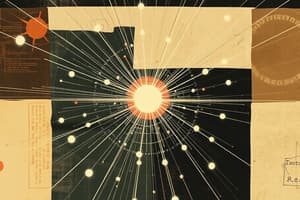Podcast
Questions and Answers
What is the main function of a photoelectric sensor?
What is the main function of a photoelectric sensor?
- Generate light through photon emission
- Detect the absence of light
- Amplify light intensity
- Detect the presence or absence of an object using light (correct)
Which of the following is NOT a component of a photoelectric sensor?
Which of the following is NOT a component of a photoelectric sensor?
- Output circuit
- Microcontroller (correct)
- Light detector (light sensor)
- Logic circuit
What is the most common type of light source used in photoelectric sensors?
What is the most common type of light source used in photoelectric sensors?
- Fluorescent tube
- Light emitting diode (LED) (correct)
- Incandescent bulb
- Xenon bulb
What is the operating principle behind LEDs in photoelectric sensors?
What is the operating principle behind LEDs in photoelectric sensors?
Which of the following is a characteristic of LEDs used in photoelectric sensors?
Which of the following is a characteristic of LEDs used in photoelectric sensors?
What is the name given to a light sensor in a photoelectric sensor that detects the absence of an object?
What is the name given to a light sensor in a photoelectric sensor that detects the absence of an object?
What is the typical dark resistance range of a photocell?
What is the typical dark resistance range of a photocell?
Which photodetector operates in two main modes called photovoltaic and photoconductive?
Which photodetector operates in two main modes called photovoltaic and photoconductive?
Which type of sensing method relies on reflected light to indicate the presence of an object?
Which type of sensing method relies on reflected light to indicate the presence of an object?
What is the main difference between opposed sensing and retro-reflective sensing?
What is the main difference between opposed sensing and retro-reflective sensing?
In convergent sensing, how are the emitter and detector positioned?
In convergent sensing, how are the emitter and detector positioned?
What does specular sensing detect based on?
What does specular sensing detect based on?
Flashcards are hidden until you start studying
Study Notes
Photoelectric Sensors
- Use light to detect the presence or absence of an object
- Detection occurs if a light beam is interrupted or reflected by the object being sensed
- Consist of five basic components: light source, light detector, lenses, logic circuit, and output circuit
Light Source (LED)
- Light emitting diodes (LEDs) are the most commonly used light source
- Can be visible or non-visible (infrared)
- Operate due to electroluminescence – the generation of photons when electron-hole pairs are created by current flow through a PN junction
- Characteristics:
- Very long lifespan (solid state devices)
- Light intensity does not deteriorate quickly
- Immune to shock and vibration
- Produce a single wavelength
- Popular for security applications (infrared)
Light Detectors
- A light sensor that detects the absence of an object is called a light sensor, detector, or receiver
- Most common light detectors:
- Photoresistors or photocells
- Photodiodes
- Phototransistors
Photocell
- A passive resistive component that decreases resistance as exposure to light increases
- Typical dark resistance: 500kΩ to 20MΩ range
Photodiode
- A semiconductor device with a P-N junction that converts photons (light) into electrical current
- Two main modes of operation:
- Photovoltaic or Unbiased Mode: illuminated photodiode generates a voltage which can be measured
- Photoconductive or Reversed Biased Mode: reverse voltage is applied to the diode where the diode will not conduct without incident light
Phototransistor
- A semiconductor device that has a light-sensitive base region
- Operation is identical to a normal transistor except the base voltage is replaced by light intensity
Photoelectric Applications
- Nightlight
- Smoke Detector
- Coin Counter
- Irradiance Sensor
Photoelectric Sensors in Industry
- Can be categorized by:
- Sensing method
- Packaging style
Sensing Methods
- Opposed sensing / through beam:
- Consists of two units, emitter and detector, positioned opposite each other
- Object is detected when it breaks the light beam
- Object must completely block the entire beam
- Detection mode is light-to-dark
- Most reliable sensing method
- Retro-reflective sensing:
- Emitter and detector contained next to each other in the same housing
- Light beam reflected back to the receiver by a prismatic reflector mounted opposite the sensor unit
- Detection mode is light-to-dark
- Not reliable for highly reflective objects, may go undetected
- Diffuse sensing:
- Emitter and detector contained next to each other in the same housing
- No need for reflector – relies on light being reflected by the surface of the object
- Reflected light indicates the object is present
- Detection mode is dark-to-light
- Reflected light is diffused and not very strong, range is limited
- Convergent sensing:
- Similar to diffuse sensing – dark-to-light detection mode
- Emitter and detector contained next to each other in the same housing
- Emitter and detector are set at the same angle from the vertical axis to capture reflected light
- Sensor is designed to detect the object at one set distance – focal point
- Objects closer or further from the focal point will not be detected
- Typically used to detect parts in place or fill level
- Specular sensing:
- Detects the difference between shiny and dull surfaces based on how the beam reflects (specular vs. diffuse)
- Emitter and receiver contained in the same housing
- The distance between the sensor and the object must remain constant
Studying That Suits You
Use AI to generate personalized quizzes and flashcards to suit your learning preferences.




